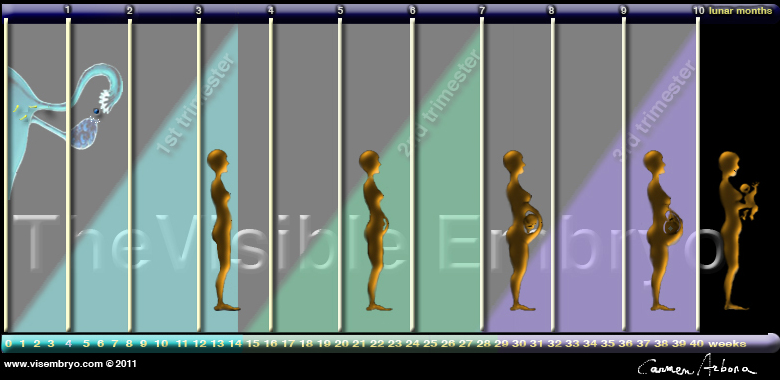|

CLICK ON weeks 0 - 40 and follow along every 2 weeks of fetal development
|
||||||||||||||||||||||||||||
|
Developmental Biology - Stem Cells How Stem Cells Lose Their Unlimited Potential "We previously thought transcription factors drove the process determining whether a gene is expressed [functioning] and subsequently translated into a corresponding protein. How a cell slowly develops from one state to another is key to understanding cell behavior in multi-cellular organisms. Stem cell researchers are constantly trying to refine techniques to develop stem cells into various specific cell types to be used, for example, in regenerating the damaged tissue of major organs. So far, however, making all cells in a dish do the same thing at the same time has been extremely difficult. A Protein Centered Viewpoint So, researchers developed a stem cell model to mimic a cell's response to signals. Using it, for the first time, to precisely determine the sequence of events in a gene being turned on and off in response to a signal. Now, they are able to describe under what circumstances a cell may develop along one pattern — and then return to its starting-point. Part of this discovery involved measuring how proteins in a cell are modified by phosphorylation by using advanced mass spectrometry available through an important collaboration with Jesper Olsen's Group at the Novo Nordisk Foundation Center for Protein Research (CPR). "Combining forces with the Olsen group in the CPR enabled us to provide a unique deep description of how individual proteins in a cell react to signals from the outside." New Answers to Old Scientific Questions The results are surprising. Although the sequence of cell transcription could not previously be measured as accurately as in this study, the dogma was: "Transcription factors are the on-off switch essential to initiate transcription of individual genes. This is not true for embryonic stem cells — and potentially not for other cell types either. "Transcription factors are still a key signal, but they do not drive the process as previously thought. This discovery is first and foremost basic knowledge, which changes fundamental assumptions in molecular biology. Thse new results are especially important for researchers working on stem cells and in cancer biology. They provide new insight into how cells develop, how pathways involved in development determine when cells change, and when the point of no return is reached. As these pathways are also found frequently mutated in cancer, the findings in this study will be valuable to the study of malignant development. "In the project, we focused on the fibroblast growth factor (FGF)-extracellular signal-regulated kinase (ERK) signalling pathway, which is a signalling pathway from a receptor on the surface of a cell to DNA inside the cell nucleus. This pathway is dysregulated in many types of cancer. Abstract Central to understanding cellular behaviour in multi-cellular organisms is the question of how a cell exits one transcriptional state to adopt and eventually become committed to another. Fibroblast growth factor-extracellular signal-regulated kinase (FGF -ERK) signalling drives differentiation of mouse embryonic stem cells (ES cells) and pre-implantation embryos towards primitive endoderm, and inhibiting ERK supports ES cell self-renewal1. Paracrine FGF–ERK signalling induces heterogeneity, whereby cells reversibly progress from pluripotency towards primitive endoderm while retaining their capacity to re-enter self-renewal2. Here we find that ERK reversibly regulates transcription in ES cells by directly affecting enhancer activity without requiring a change in transcription factor binding. ERK triggers the reversible association and disassociation of RNA polymerase II and associated co-factors from genes and enhancers with the mediator component MED24 having an essential role in ERK-dependent transcriptional regulation. Though the binding of mediator components responds directly to signalling, the persistent binding of pluripotency factors to both induced and repressed genes marks them for activation and/or reactivation in response to fluctuations in ERK activity. Among the repressed genes are several core components of the pluripotency network that act to drive their own expression and maintain the ES cell state; if their binding is lost, the ability to reactivate transcription is compromised. Thus, as long as transcription factor occupancy is maintained, so is plasticity, enabling cells to distinguish between transient and sustained signals. If ERK signalling persists, pluripotency transcription factor levels are reduced by protein turnover and irreversible gene silencing and commitment can occur. Authors William B. Hamilton, Yaron Mosesson, Rita S. Monteiro, Kristina B. Emdal, Teresa E. Knudsen, Chiara Francavilla, Naama Barkai, Jesper V. Olsen and Joshua M. Brickman. Acknowledgments The authors thank M. Thomson for the NANOG–eGFP ES cells, T. Kunath for Erk2-KO cells, N. Festuccia for Esrrb-KO cells, H.H. Ng for the KLF2 and TFCP2L1 antibodies, the Brickman laboratory members for critical discussions, Y. Spector for sequencing assistance, H. Neil, M. Michaut and the DanStem Genomics Platform for technical expertise, support, and the use of instruments, S. Pozzi, N. Festuccia and P. Navarro Gil for advice on ChIP protocols, K. Stewart-Morgan for help with ATAC-seq, A. Azad and J. A. R. Herrera for bioinformatics advice and P. van Dieken for technical support and proof reading. This work was funded by grants from the Novo Nordisk Foundation, Danish Council for Independent Research (8020-00100B), Danish National Research Foundation (DNRF116) and Human Frontiers in Science (RGP0008/2012). The Novo Nordisk Foundation Centers for Stem Cell Biology and Protein Research are supported by a Novo Nordisk Foundation grant numbers NNF17CC0027852 and NNF14CC0001. R.S.M. is supported by a fellowship from the Lundbeck Foundation (R303-2018-2939). Return to top of page. | Nov 15 2019 Fetal Timeline Maternal Timeline News  Embryonic stem cells beginning to differentiate into unique cell tissues. CREDIT University of Copenhagen.
|
||||||||||||||||||||||||||||

